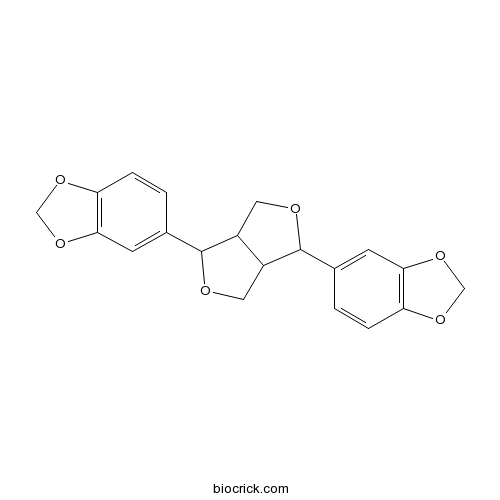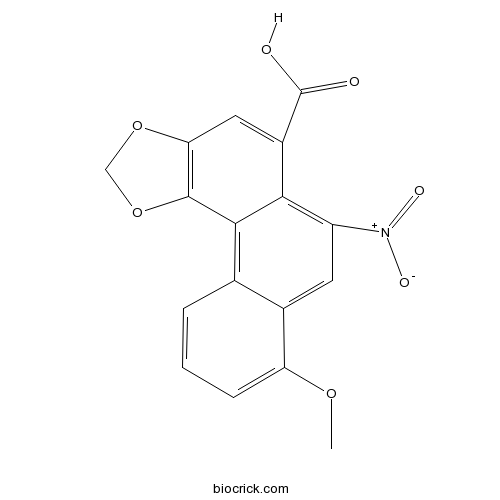Asarum sieboldii
Asarum sieboldii
1. The products in our compound library are selected from thousands of unique natural products; 2. It has the characteristics of diverse structure, diverse sources and wide coverage of activities; 3. Provide information on the activity of products from major journals, patents and research reports around the world, providing theoretical direction and research basis for further research and screening; 4. Free combination according to the type, source, target and disease of natural product; 5. The compound powder is placed in a covered tube and then discharged into a 10 x 10 cryostat; 6. Transport in ice pack or dry ice pack. Please store it at -20 °C as soon as possible after receiving the product, and use it as soon as possible after opening.
Natural products/compounds from Asarum sieboldii
- Cat.No. Product Name CAS Number COA
-
BCN2290
(-)-Asarinin133-04-0
Instructions

-
BCN6262
Aristolochic acid A313-67-7
Instructions

-
BCN2818
Elemicin487-11-6
Instructions

Fumigant Toxicity of Phenylpropanoids Identified in Asarum sieboldii Aerial Parts to Lycoriella ingenua (Diptera: Sciaridae) and Coboldia fuscipes (Diptera: Scatopsidae).[Pubmed: 26470247]
Lycoriella ingenua (Dufour) (Diptera: Sciaridae) and Coboldia fuscipes (Meigen) (Diptera: Scatopsidae) are two of the most economically important insect pests of cultivated mushrooms. The toxicities to the fly larvae of the three phenylpropanoids (methyleugenol, myristicin, and safrole) from aerial parts of Asarum sieboldii Miquel (Aristolochiaceae) were compared with those of the currently available carbamate insecticide benfuracarb. In a contact+fumigant mortality bioassay with L. ingenua and C. fuscipes larvae, methyleugenol (1.46 and 2.33 µg/cm2) was the most toxic compound, followed by safrole (2.03 and 2.59 µg/cm2) and myristicin (3.59 and 4.96 µg/cm2), based on 24-h LC50 values. The phenylpropanoids were less toxic than benfuracarb (LC50, 0.75 and 0.55 µg/cm2). In vapor-phase mortality tests with the larvae, the phenylpropanoids were consistently more toxic in closed versus open containers, indicating that the effect of the compounds was largely a result of vapor action. Global efforts to reduce the level of highly toxic synthetic insecticides in the agricultural environment justify further studies on A. sieboldii plant-derived products as potential fumigants for the control of mushroom fly populations in mushroom houses and mushroom compost.
[Qualitative and quantitative analysis of dodecatetraenamides A, B in Asari Radix et Rhizoma].[Pubmed: 26137692]
To develop an analytic method for qualitative and quantitative analysis of dodecatetraenamides A, B in 42 samples of two official species of Asari Radix et Rhizoma( ARR) (37 samples of Asarum heterotropoides var. mandshuricum with different collection time and 5 samples of Asarum sieboldiivar. seoulense). The HPLC-IT-TOF-MS/MS methods for the qualitative and UPLC-PDA methods for the quantitative analysis were established. Dodecatetraenamides A, B were identified by comparing the retention time, UV absorption spectrum and quasi-molecular ion peak [ M + H]+ with the reference compound using HPLC-IT-TOF-MS/MS. The content of dodecatetraenamides A and B in ARR were determined by UPLC-PDA. The separation was successfully carried out on a ACQUITY UPLC BEH C18 (2.1 mm x 100 mm, 1.7 µm) column eluted with mobile phases of water (A) and acetonitrile (B) in gradient program (0-3 min, 35% B; 3-5 min, 35%-36% B; 5-6 min, 36%-43% B; 6 min-11 min 43% B; 11-12 min, 43%-100% B). The column temperature was 45 °C, and the detection wavelength was set at 254 nm. The flow rate was 0.6 mL · min(-1). On one level mass spectrometry scanning, the results showed that the quasi-molecular ion [M + H] + of both dodecatetraenamides A and B were m/z 248.20. The quantitative method with UPLC-PDA has made the baseline separation of the constituents, which were reported as mixtures in the most literatures. The average recovery of dodecatetraenamides A and B were 97.90% and 99.86%, the relative standard deviation were 0.4% and 1.1%, respectively. The contents of dodecatetraenamides A, B in all ARR samples was in the range of 0.11-3.89 and 0.24-6.65 mg · g(-1). Their contents reduced with the extension of storage time. Compared with the samples of 2013, the average content of the two constituents in the samples collected in year 2002-2003 reduced 34% and 36%, respectively (P < 0.05). Compared the A. sieboldii var. seoulense and A. heterotropoides var. mandshuricum with the same collective time and production area, the average contents of the two constituents in latter were up to (1.59 ± 0.75) mg · g(-1) and (2.90 ± 1.17) mg · g(-1), respectively, significantly higher than that in A. sieboldii var. seoulense (dodecatetraenamide A were (0.78 ± 0.52) mg · g(-1), dodecatetraenamide B were (1.69 ± 0.83) mg · g(-1)) (P < 0.05). The content of the dodecatetraenamide A in overground part was in the range of 0.11-0.33 mg · g(-1), dodecatetraenamide B was 0. 24-0.60 mg · g(-1), which were much lower than that of the underground part of ARR (dodecatetraenamide A was in the range of 0.73-3.89 mg · g(-1), dodecatetraenamide B was 2.11-6.24 mg · g(-1)). The method was certified to be simple, accurate and reliable and could be used for qualitative and quantitative analysis of dodecatetraenamide A and B in different species of ARR, also can be used for the comprehensive quality control of traditional Chinese medicine, Asari Radix et Rhizoma.
Screening and identification of phytotoxic volatile compounds in medicinal plants and characterizations of a selected compound, eucarvone.[Pubmed: 25534256]
Screening and identification of phytotoxic volatile compounds were performed using 71 medicinal plant species to find new natural compounds, and the characterization of the promising compound was investigated to understand the mode of action. The volatile compounds from Asarum sieboldii Miq. showed the strongest inhibitory effect on the hypocotyl growth of lettuce seedlings (Lactuca sativa L.cv. Great Lakes 366), followed by those from Schizonepeta tenuifolia Briquet and Zanthoxylum piperitum (L.) DC.. Gas chromatography-mass spectrometry (GC/MS) identified four volatile compounds, α-pinene (2,6,6-trimethylbicyclo[3.1.1]hept-2-ene), β-pinene (6,6-dimethyl-2-methylenebicyclo[3.1.1]heptane), 3-carene (3,7,7-trimethylbicyclo[4.1.0]hept-3-ene), and eucarvone (2,6,6-trimethy-2,4-cycloheptadien-1-one), from A. sieboldii, and three volatile compounds, limonene (1-methyl-4-(1-methylethenyl)-cyclohexene), menthone (5-methyl-2-(propan-2-yl)cyclohexan-1-one), and pulegone (5-methyl-2-propan-2-ylidenecyclohexan-1-one), from S. tenuifolia. Among these volatile compounds, eucarvone, menthone, and pulegone exhibited strong inhibitory effects on both the root and shoot growth of lettuce seedlings. Eucarvone-induced growth inhibition was species-selective. Cell death, the generation of reactive oxygen species (ROS), and lipid peroxidation were induced in susceptible finger millet seedlings by eucarvone treatment, whereas this compound (≤158 μM) did not cause the increase of lipid peroxidation and ROS production in tolerant maize. The results of the present study show that eucarvone can have strong phytotoxic activity, which may be due to ROS overproduction and subsequent oxidative damage in finger millet seedlings.
Simultaneous determination of twenty-two components in Asari Radix et Rhizoma by ultra performance liquid chromatography coupled with quadrupole time-of-flight mass spectrometry.[Pubmed: 25513865]
Asari Radix et Rhizoma is a herbal medicine for the treatment of common cold, rhinitis, etc. An ultra performance liquid chromatography coupled with quadrupole time-of-flight mass spectrometry method has been established for the rapid analysis of 22 components in 27 samples from the raw materials of Asari Radix et Rhizoma and an adulterant. A total of 5 lignans, 5 essential oils, 3 aristolochic acids, 4 alkamides, and 5 flavanoids were identified by co-chromatography of samples extracts and comparison of the retention time, UV spectra, characteristic molecular ions, and fragment ions with those of authentic standards, or tentatively identified by MS/MS determination along with MassFragment software. Moreover, the method was validated for the simultaneous quantification and semi-quantification of 20 components. The samples from Asarum heterotropoides var. mandshuricum differed in the quantity of 2-methoxyl-4,5-methylenedioxypropiophenone and kakuol from those of Asarum sieboldii var. seoulense, and the chemical difference was supported by principal component analysis and orthogonal partial least squared discriminant analysis based on dataset obtained from UHPLC-QTOF/MS. In comparison with the samples from the two medicinal Asarum species mentioned above, those from A. himalaicum differed in the quality and quantity of major compounds and contained higher amounts of aristolochic acid I.


